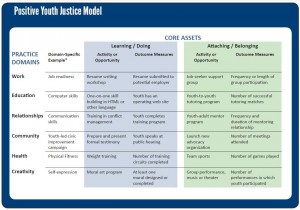 We often assume that teens land in the juvenile justice system because they're "villains" or victims (of trauma, circumstance, or a behavioral health issue like substance abuse). But what if we used a different lens?
We often assume that teens land in the juvenile justice system because they're "villains" or victims (of trauma, circumstance, or a behavioral health issue like substance abuse). But what if we used a different lens?
What if we assumed that teens commit crimes to meet needs typical of of all adolescents? After all, during this phase of development, teens want excitement, power, status, and a sense of belonging. (Plus, they're not strong on empathy, paving the way for criminal behavior.)
Using this lens instead of a villain/victim lens means changing what we do. It means working with communities to help teens meet their developmental needs in more positive, constructive ways, so they can live crime-free lives.
While this "positive youth development" approach is not blind to the fact that teens' delinquent behavior has real consequences and real victims, or to the fact that young people in the justice system also need behavioral health care, physical health care, and other services, it makes use of a largely-untapped source of positive change. Rather than focus on fixing their deficits, it helps youth identify and grow their assets and strengths.
You'll find all this in a great report from the Coalition of Juvenile Justice, titled, "Positive Youth Justice: Framing Justice Interventions Using the Concepts of Positive Youth Development," authored by Jeffrey Butts, Gordon Bazemore, and Aundra Saa Meroe.
In it, the authors propose that positive youth development can be used as a framework for designing general interventions with young people in the juvenile justice system. (See above for their matrix, taken from page 31 of the document.) As they explain it:
"The Positive Youth Justice Model ... includes 12 key components depicted as a 2 by 6 matrix. Each cell in the matrix represents the interaction of two key assets needed by all youth: (1) learning/doing, and (2) attaching/belonging. Each asset should be developed within the context of six separate life domains (work, education, relationships, community, health, and creativity)."

Of course, the matrix is only a guide. (And bear in mind that the activities listed in the matrix are only examples. In theory, a fully-developed approach would include more than one activity in each of the six domains, and they would be tailored to youth interests and what was available in the community.)
But the matrix could be powerfully transformative for juvenile justice systems as well as youth. In fact, it suggests new ways to measure youth success:
The Positive Youth Justice Model also encourages practitioners to rely on the two assets and six domains as they design measurement strategies for evaluation and performance monitoring. In the health domain, for example, the [m]odel reminds practitioners that they need to measure whether youth are gaining the knowledge and experience to live healthy lives, but they also need to track whether youth form stronger attachments as they apply knowledge and gain experience. Thus, measurement strategies must do more than track a youth's participation in vigorous exercise and any improvements in stamina and fitness. Practitioners need to measure a youth's sense of belonging and group attachment as it relates to physical activity. Using subjective measures such as interviews and questionnaires, a practitioner might ask youth to describe their feelings about group membership. Do their feelings grow more positive over time in relation to their participation in fitness activity? Using objective measures such as behavioral observation, do youth collaborate effectively in team sports and does their level of collaboration improve over time?
One can immediately see the power of this approach, especially with youth in recovery from alcohol and drug treatment -- their developmental needs are identical to youth who are not in recovery, and they, too, need help learning to have fun and contribute to their communities in positive ways.
The above story is reprinted with permission from Reclaiming Futures, a national initiative working to improve alcohol and drug treatment outcomes for youth in the juvenile justice system.